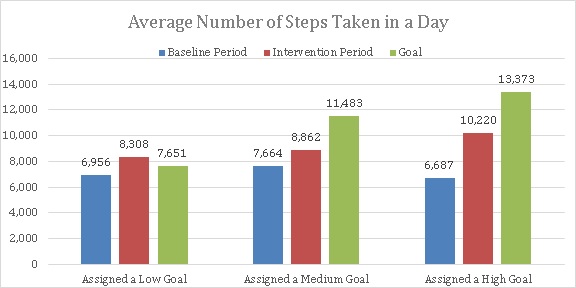
Aim High, Walk Far
Organization : Center for Health Incentives and Behavioral Economics
Project Overview
Project Summary
University staff members were given high, medium, or low goals for the number of steps they should walk in a day.
Impact
Staff members who were given a high goal walked an average of 1,358 more steps per day than those who were given a medium goal, and 1,912 more steps per day than those given a low goal.
Challenge
The use of technologies like pedometers to track daily step counts has become an especially popular way for people to improve their exercise habits, but simply giving people feedback on their own exercise behavior may not be enough. By applying insights from the behavioral sciences, we can optimize the design of self-monitors and enhance their potential effectiveness.
Design
University staff members received a pedometer with a seven day memory and used a log sheet to record when they put on and took off the pedometer each day. For the first week of the intervention, researchers modified the pedometers with tamper-proof ties so that participants couldn’t see their step counts. After six days, the researchers removed the ties, calculated the average number of steps taken by each participant, and assigned participants either a high, medium or low goal for the number of steps they should aim to take in a day. High goals corresponded to a 100% increase over the average number of steps taken by a participant in a day. Medium goals corresponded to a 50% increase, and low goals corresponded to a 10% increase. Participants then continued to use their pedometers for two weeks. During that period, they maintained a daily log recording the times they wore the pedometer, and circled a smiling or frowning face to indicate whether they had met their daily goal.
Impact

A randomized evaluation found that staff members assigned a high goal walked an average of 1,358 more steps per day than their colleagues who were assigned a medium goal, and 1,912 more steps per day than those assigned a low goal. Those who received a medium goal only walked a statistically insignificant 554 more steps per day than those who received a low goal.
Participants were most motivated by their assigned goals when they had achieved their goal on the previous day. However, although high goals yielded the greatest average effect, 40% of participants who were assigned high goals were never able to reach their goal, compared to just 16% of participants with medium goals and 4% of participants with low goals.
Implementation Guidelines
Inspired to implement this design in your own work? Here are some things to think about before you get started:
- Are the behavioral drivers to the problem you are trying to solve similar to the ones described in the challenge section of this project?
- Is it feasible to adapt the design to address your problem?
- Could there be structural barriers at play that might keep the design from having the desired effect?
- Finally, we encourage you to make sure you monitor, test and take steps to iterate on designs often when either adapting them to a new context or scaling up to make sure they’re effective.
Additionally, consider the following insights from the design’s researcher:
- Providing personalized, high goals can enhance the effectiveness of exercise self-trackers even if the goal may be unrealistic.
- Adding a leaderboard to existing self-monitoring products that allows for social comparisons can motivate people to exercise more.
For more guidance on implementing this design, select “I want to try this” from the left drop-down menu.
Project Credits
Researchers:
Gretchen Chapman Contact Institute for Health, Healthcare Policy, and Aging Research, Rutgers University
Helen Colby Anderson School of Management, University of California, Los Angeles
Kimberly Convery Institute for Health, Healthcare Policy, and Aging Research, Rutgers University
Elliot Coups Rutgers Cancer Instituteof New Jersey, Rutgers University


